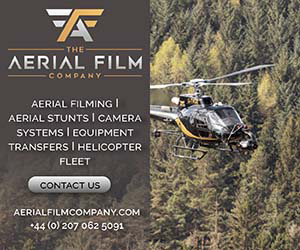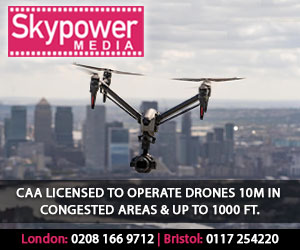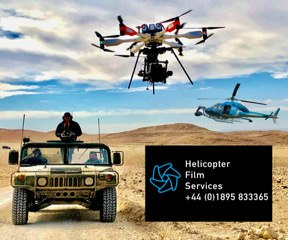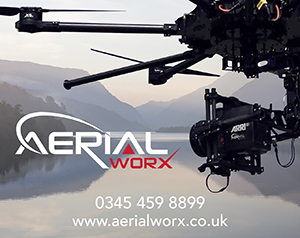Broadcast News
27/11/2015
Aerial Filming: Qualifications & Regulations
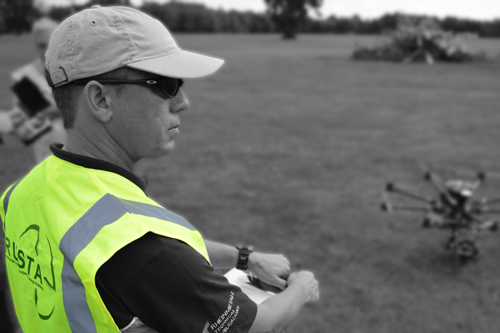
Competition in the UK for media production is fierce.
Not only is it crucial to find new ways to produce and package the final product, but it is imperative to keep up with constantly evolving trends in technology in order to provide the leading edge for customers.
For most media or film production companies this has meant delving into the world of Unmanned Aerial Vehicles (UAVs) to gain a variety of angles to differentiate their product from their competitors and enhance the final output. But what is required before taking to the skies?
Whatever you choose to call them, UAVs, drones, RPAS or UAS, they are aircraft that are sharing airspace with many other users including commercial air transport, the military and general aviation operators such as gliders and microlights. This is why the CAA have made it mandatory to gain a recognised qualification prior to using a UAV for commercial work.
So what do you need to do to gain a recognised qualification?
The CAA have put checks in place to ensure only National Qualified Entities (or NQEs) can provide this type of approved training. Rheinmetall Unmanned Systems Training Academy (RUSTA), one such NQE, sets the standards high so all pivotal information is covered and the highest safety standard is maintained.
To gain the Remote Pilot Certificate SUAS (RPCS) qualification from RUSTA, and become legally allowed to operate in the UK, candidates initially log on to Computer Based Training, which provides information into UK airspace rules and regulation. They complete a theory course over 2.5 days, generate an Operations Manual and finally take a basic Flight Test to ensure safety checks are carried out and standards are upheld at all times.
You now have a qualification, so are you ready to fly?
After gaining the RPCS qualification, candidates apply to the CAA for their Permission For Aerial Work (PFAW). This is a basic process whereby the NQE provides a written recommendation to the candidate and they submit this, along with their Operations Manual, directly to the CAA.
Are there any restrictions to where I can fly?
As mentioned, there are a variety of users in UK airspace which means there are restrictions on where UAV operators can fly. The first question that needs to be asked is, ‘Am I flying in controlled or uncontrolled airspace?’ Airspace is divided into these two recognised areas and if flying in controlled airspace extra permissions are required to be carried out prior to take-off.
As common sense prevails, there is also the requirement to ensure Visual Line Of Sight (VLOS) is maintained at all times. VLOS includes the condition of flying no higher than 400 feet and no further than 500 meters from the remote pilot.
UAV operators must also adhere to not flying over or within 150 metres of any congested area of a city, town or settlement (this is reduced to 50m for vehicles under 7kg) or within 50 metres of any person, vessel, vehicle or structure not under the control of the Remote Pilot; during take-off or landing.
To fly beyond these regions, special permission can be gained by the CAA after the initial PFAW is gained.
For production companies and media specialists that wish to differentiate their product and delve into the world of UAVs, please contact RUSTA for further information. Call +44 (0)1454 643 100 or email info@uastraining.com.
www.rheinmetall.com
www.uastraining.com
Not only is it crucial to find new ways to produce and package the final product, but it is imperative to keep up with constantly evolving trends in technology in order to provide the leading edge for customers.
For most media or film production companies this has meant delving into the world of Unmanned Aerial Vehicles (UAVs) to gain a variety of angles to differentiate their product from their competitors and enhance the final output. But what is required before taking to the skies?
Whatever you choose to call them, UAVs, drones, RPAS or UAS, they are aircraft that are sharing airspace with many other users including commercial air transport, the military and general aviation operators such as gliders and microlights. This is why the CAA have made it mandatory to gain a recognised qualification prior to using a UAV for commercial work.
So what do you need to do to gain a recognised qualification?
The CAA have put checks in place to ensure only National Qualified Entities (or NQEs) can provide this type of approved training. Rheinmetall Unmanned Systems Training Academy (RUSTA), one such NQE, sets the standards high so all pivotal information is covered and the highest safety standard is maintained.
To gain the Remote Pilot Certificate SUAS (RPCS) qualification from RUSTA, and become legally allowed to operate in the UK, candidates initially log on to Computer Based Training, which provides information into UK airspace rules and regulation. They complete a theory course over 2.5 days, generate an Operations Manual and finally take a basic Flight Test to ensure safety checks are carried out and standards are upheld at all times.
You now have a qualification, so are you ready to fly?
After gaining the RPCS qualification, candidates apply to the CAA for their Permission For Aerial Work (PFAW). This is a basic process whereby the NQE provides a written recommendation to the candidate and they submit this, along with their Operations Manual, directly to the CAA.
Are there any restrictions to where I can fly?
As mentioned, there are a variety of users in UK airspace which means there are restrictions on where UAV operators can fly. The first question that needs to be asked is, ‘Am I flying in controlled or uncontrolled airspace?’ Airspace is divided into these two recognised areas and if flying in controlled airspace extra permissions are required to be carried out prior to take-off.
As common sense prevails, there is also the requirement to ensure Visual Line Of Sight (VLOS) is maintained at all times. VLOS includes the condition of flying no higher than 400 feet and no further than 500 meters from the remote pilot.
UAV operators must also adhere to not flying over or within 150 metres of any congested area of a city, town or settlement (this is reduced to 50m for vehicles under 7kg) or within 50 metres of any person, vessel, vehicle or structure not under the control of the Remote Pilot; during take-off or landing.
To fly beyond these regions, special permission can be gained by the CAA after the initial PFAW is gained.
For production companies and media specialists that wish to differentiate their product and delve into the world of UAVs, please contact RUSTA for further information. Call +44 (0)1454 643 100 or email info@uastraining.com.
www.rheinmetall.com
www.uastraining.com
More Aerial Filming Stories
31/01/2023
Flying Features Relies On LiveU
For the third year in a row, the Santos Tour Down Under cycling race was broadcast live from the sky by Australian aerial filming company Flying Featu
Flying Features Relies On LiveU
For the third year in a row, the Santos Tour Down Under cycling race was broadcast live from the sky by Australian aerial filming company Flying Featu
02/06/2017
Live Video Streaming From Drones
Drones provide a mechanism for streaming compelling video that other methods cannot compete with, either from an infrastructure or cost prospective. W
Live Video Streaming From Drones
Drones provide a mechanism for streaming compelling video that other methods cannot compete with, either from an infrastructure or cost prospective. W
26/04/2017
360 Design Announce Flying EYE
360 Designs has announced the launch of Flying EYE, a groundbreaking, 6K, broadcast quality, live streaming VR drone. According to the company the ann
360 Design Announce Flying EYE
360 Designs has announced the launch of Flying EYE, a groundbreaking, 6K, broadcast quality, live streaming VR drone. According to the company the ann
12/04/2017
Festival Recognition For Shetland My Land, My Home
Article contributed by Thomas Haywood, from Thomas Haywood Aerial Photography. Recently, I entered Shetland My Land, My Home into several film festiva
Festival Recognition For Shetland My Land, My Home
Article contributed by Thomas Haywood, from Thomas Haywood Aerial Photography. Recently, I entered Shetland My Land, My Home into several film festiva
31/03/2017
Drone Use In Construction Industry - Part 1
In the first of a two-part report into drones and construction, Jim Meehan, an aerial imaging specialist at SkyHeld Cameras, asks if data quality or s
Drone Use In Construction Industry - Part 1
In the first of a two-part report into drones and construction, Jim Meehan, an aerial imaging specialist at SkyHeld Cameras, asks if data quality or s
31/03/2017
Drone Use In Construction Industry - Part 2
In the second of a two-part report into drones and construction Jim Meehan, aerial imaging specialist at SkyHeld Cameras, rounds up the reasons that d
Drone Use In Construction Industry - Part 2
In the second of a two-part report into drones and construction Jim Meehan, aerial imaging specialist at SkyHeld Cameras, rounds up the reasons that d
30/03/2017
GoPro Karma Now Available In The UK
GoPro have announced that it's complete Karma system is now available at selected online and high street retailers. Karma features a compact design an
GoPro Karma Now Available In The UK
GoPro have announced that it's complete Karma system is now available at selected online and high street retailers. Karma features a compact design an
08/03/2017
Hovercam Goes On The Hunt For Sharks
Hovercam's Benet Allen went shark-baiting with the team from ITV's Fishing Impossible... They told us it was going to be straightforward, if a bit sme
Hovercam Goes On The Hunt For Sharks
Hovercam's Benet Allen went shark-baiting with the team from ITV's Fishing Impossible... They told us it was going to be straightforward, if a bit sme
23/01/2017
Producing Live UHD/4K Aerial Footage On Budget
Just a few years ago, the only option of producing professional, dynamic live aerial footage was renting a turbine driven helicopter equipped with a h
Producing Live UHD/4K Aerial Footage On Budget
Just a few years ago, the only option of producing professional, dynamic live aerial footage was renting a turbine driven helicopter equipped with a h
20/01/2017
BFV's Big Interview: BeyondHD
With 20 years specialising in aerial and vehicle-based stabilised remote head filming equipment and crew hire – from manned aerial filming and class l
BFV's Big Interview: BeyondHD
With 20 years specialising in aerial and vehicle-based stabilised remote head filming equipment and crew hire – from manned aerial filming and class l






